A Few Remarks on Music Teaching, Part II
Editor’s Note, by Heidi Buschbach
Our author, W.H. Leslie, wrote Part II of this article and it was included in a later printing of The Parents’ Review that year. Part I focused on the early years of teaching Sol-fa which included basic things such as having good tone, training the ear to hear pitch, melody, and intervals, and learning to feel and understand rhythm. Part II will now take us through how to teach some of the more complex aspects of Tonic Sol-fa or Solfege, once the student has mastered the basics.
By W. H. Leslie
The Parents’ Review, 1926, pp. 118–128
WE now come to the classes in which, if the foundations indicated in Part I. are well and truly laid, we shall be able to make considerable progress.
The scale is treated as a whole. The 4th (FA) and 7th (TE) being always used.
Breathing and Production.
Great care and attention should be given to breathing and production now, as, if good habits are acquired early, they remain all through the children’s training and are permanent.
The “suggestions” from the Board of Education go fully into the matter, and the system set forth is admirably suited to the requirements.
Though at first sight these exercises seem to be more or less routine—in reality they require a very full measure of concentration of thought. Anyone can make a sound of some kind, but to use the voice and breathing properly it demands the fullest attention.
One or two points I would like to suggest:
(1) Aim at getting all singing as ![]() [quiet] as possible. The less sound the teacher gives the more attention is required on the part of children to hear it, and this sets the small mind more on the alert.
[quiet] as possible. The less sound the teacher gives the more attention is required on the part of children to hear it, and this sets the small mind more on the alert.
When children are apparently not susceptible to sound at all it will be often found that by getting them to listen to the smallest whisper of a note the brain is more concentrated on the effort to hear and soon assimilates the sound.
In a short time many overcome what looks at first like a total inability to appreciate any difference between one note and another.
(2) Practise children often with the lips closed—i.e., humming—get them to gradually open the lips as in ordinary speaking—not wide open, and imagine they are singing at their upper row of teeth. Avoid any tendency to harshness which so often appears when the demand is made for loud tone as the higher notes are wanted.
This harshness will often yield to a little practice on a syllable like TEE. First get it spoken and gradually increase the sound until it becomes singing. See that everything is kept non-rigid. As Mr. Charles Tree expresses it—“A smile is the right amount of ‘open mouth,’” and also entails loose muscles—any tendency to a rigid chin or throat is wrong. A smile is loose and pleasant, a grin is the reverse.
Start with the three or four middle notes of the voice and gradually add to these up and down.
As a rule children expend far too much breath in producing singing sounds.
Try and get them to “hold their breath” when singing, in the same way as they would if their heads were under water.
These remarks are not meant as a scientific exposition of “voice production,” but more as hints which, if acted upon, will not at any rate be harmful to the voices and will probably help to avoid shaky intonation.
In junior classes I attach considerable importance to very soft singing, the less sound produced the more attention is required to hear it.
What we call a “good ear” is not really the use of the hearing faculty only, but through the ear the sound required is conveyed to the brain and the reproduction of it depends for its facility and accuracy on the power of assimilation which the brain possesses.
Editor’s Note: If you find that your child is having difficulty with matching pitch, or notes, you are singing, please take note of these ideas. As he says, a “good ear” isn’t just a hearing faculty, but requires careful attention with the brain in order to reproduce or “narrate” back the sound!
It follows that if the sound required is given with a minimum of volume, i.e., as nearly a whisper as possible, the brain is at once concentrated on the effort to hear it, and the repose thus obtained makes for the accurate reproduction and avoids the “excitements” of less considered efforts, which so often account for faulty intonation and other drawbacks.
We are not teaching cathedral choirs. The voices change after they leave school and we want to keep them from harmful habits which will react later on.
But it all requires great mental concentration—always difficult to cultivate—more, perhaps, with adults than with children. And this very concentration is a valuable educational asset.
Staff Notation.
It is now that the transference from the Sol-fa Notation to the Staff begins to be considered, and for this purpose I should like those whose teaching will ultimately lead to the Staff Notation to see the idea on which the Staff Notation was originally founded.
The use of the letters of the alphabet for the names of the notes comes down to us from antiquity, and when, later on, notation was started by the monks, they used a stave of eleven lines—which covered the range of the average human voice, male and female. On these lines they placed the letters indicating the place of certain notes.
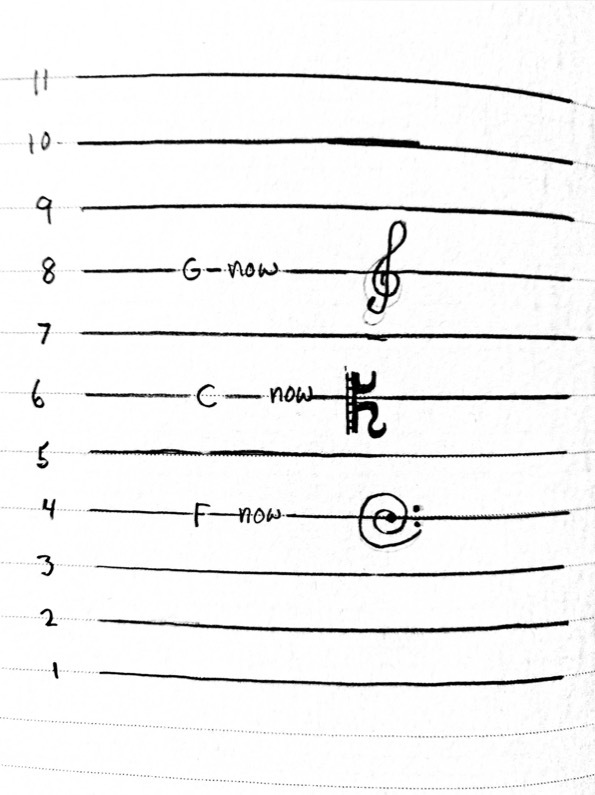
The middle sound or note common to all voices was marked with a C. The two lines above it was marked with a G, and the two lines below it with an F. These are the fifth above and the fifth below, and are the Tonic, the Sol and the Fa of the Key of C.
The Clef signatures now in use are really only embellished editions of G, C and F.
The only difference that occurs to-day is that the line on which the middle C is now written is left out and the two staves of 5 lines appear separately with a short Ledger line usually written through the C.
The above letters, C, G and F, have since been modified
into what we now know as the Treble Clef, the Tenor and Alto Clef and the Bass Clef, and the five lines which denote the average compass of such voices only are used, as follows:—
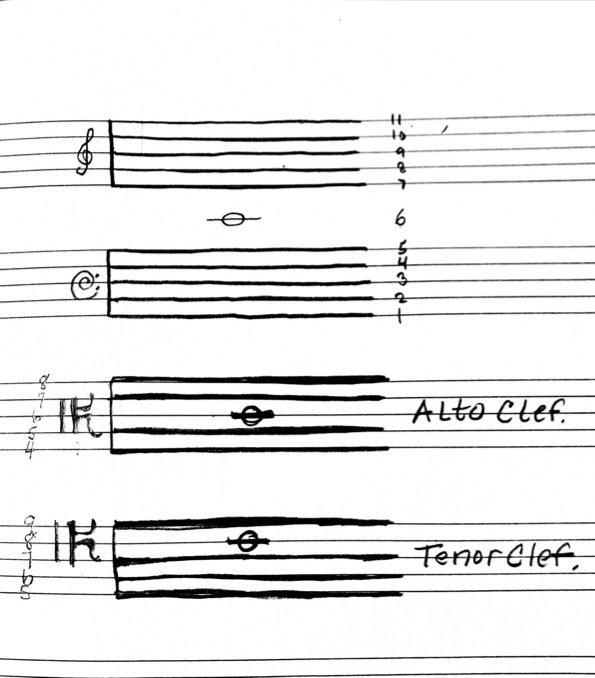
Note.—I have numbered the lines so that by comparing the numbers it will be seen that the Tenor and Alto Clef indicate the middle C of the large eleven line stave.
There is nothing in this which need be taught in elementary schools, it is only quoted here in order that the teachers have in their mind the construction of our musical notation.
As you all know, the tenor and alto clef are seldom used now, the ![]() G clef being made to do duty for all the voices other than the bass, but for the tenor parts the sound is transposed an octave lower, and for the alto part ledger lines are
G clef being made to do duty for all the voices other than the bass, but for the tenor parts the sound is transposed an octave lower, and for the alto part ledger lines are
very frequent, thus obtaining simplicity at the expense of common-sense.
The simplest method of teaching the transference from the one notation to the other is by making use of what is known as the Movable Doh, which, of course, means that Doh is always used as the Key Note in the major keys, and as this is quite well known to you all I need not dwell upon it.
Editor’s Note: Our author assumes some musical proficiency when he says “this is quite well known to you all I need not dwell upon it,” doesn’t he? Moveable Doh, simply means that Doh is always the Key note, Tonic note or first note in a Major scale. So if you play a scale in the key of C, then C is the first note of the scale and will use the sol-fa syllable Doh. If you play a song in the key of G, then G is the tonic or Key note and since Doh is moveable, G becomes Doh and the starting note for the new scale and key signature. If you would like to learn more about Moveable Doh, I suggest you do a Google search and you will come up with lots of information.
I am not at all sure that the difficulties of this transference are not over-laboured in our teaching, and I think that if a tolerable familiarity with the notes indicated by the Tonic Sol-fa syllables is obtained, and the notation, viz., time signatures, notes, bars and rests are explained, and then the text-books are used which have both notations together,[1] a familiarity with the Staff Notations comes more or less gradually, and is fairly easily picked up by children, and, at any rate, is sufficiently serviceable for all practical purposes of reading music at sight for singing. Also, in this way, if the children have books to sing from, very good sight reading exercises are readily obtainable by putting the songs as they are learning them on to a blackboard with alterations in unexpected places, so that you can make sure that the children are paying attention and singing really from the notes they see, and not because they think it is a tune they know.
If they are always expecting a trap, it keeps the attention and concentration, and these soon become a habit.
Facility in sight-reading can also be assisted very much by writing down a tune the children know well. First make them think of the “time” and at first write down the time values only on one note, then give the Doh and make them think out the intervals and reproduce the time. It is the reverse of the ordinary sight-reading, and relieves the monotony.
It becomes increasingly difficult now to discover whether children are really reading the intervals for themselves or whether they are following other voices.
I expect that you have all experienced the great difficulty of teaching large classes, such as you have to deal with. This, of course, is unavoidable in our schools, and has to be dealt with.
A skilful child leads the others so easily.
A difference of opinion in reading easily upsets a class.
Individual and independent effort is not easily obtained.
We must try to separate (1) those who really read, (2) those who follow those that really read, (3) those that guess on their own account.
Reading at sight is at best a very jumpy proceeding, and the slightest indication of uncertainty by a neighbouring voice or voices upsets the equilibrium of a class quicker than anything, especially if there is an absence of individual effort.
It is very good practice indeed for ensuring the general effort of a class, as opposed to the more skilful children carrying the passengers on their backs, to do modulator exercises or sight-reading tests with each child taking up the successive interval alone. This entails the whole class following the exercises and being ready to sing their note when it comes to their turn.
Editor’s Note: I believe what he is describing here involves the children all sight reading a piece of music together, but only one singing a section at a time, while the others listen with full attention. I find this interesting and very similar to how I do group narrations with my CM community. One child begins the narration and then another might jump in at the middle of the story. This ensures that all were giving their full attention to the work. I think this method would also result in careful attention to the music reading and in some ways the singing back of it, is their brain’s narration, an “act of knowing” that helps them to learn and shows that they are being attentive to their music reading.
Directly children realise what is expected of them they become ready to sing their note and even more ready to detect mistakes on the part of their neighbours, and this adds considerable interest to what otherwise may be a dull performance, and is thoroughly characteristic of human nature.
It is always easier to detect mistakes in others than to do a thing correctly oneself.
Many of our difficulties find themselves through our making music appeal more to the senses than to the intellect, I mean, that we allow so much singing by ear, that we are inclined to let it go at that and not make sure of our foundations.
It is very difficult to avoid this unless considerable care is taken.
We so often find that infants and quite small children are thoroughly enthusiastic over their music classes, it being the first school work that they do really well.
Gradually as they go up the school, and less attention is given to the understanding than to the execution, enthusiasm gradually dies down unless in the hands of a very exceptional instructor; but where music is no speciality of the teacher things are allowed very often to take their own course, and the song singing gets a kind of perfunctory exercise without enthusiasm either by the teacher or the children. Where this atmosphere obtains in any school, it is really advisable to confine much more to theoretical exercises than allow music to become a hum-drum performance.
The exercises in reading and general knowledge of the ways of music are always a valuable asset to anybody, whereas the teaching of songs and so on by people who have no particular liking for them themselves is bound to be reflected on the class generally.
There must always be among us a number of teachers to whom music quâ music makes a modified appeal, but these can none the less assist in many directions.
Invaluable help can be given to children, although the actual performance of music and songs may not materialise.
All matters relating to rhythm can be thoroughly well taught, without the slightest knowledge of the sounds which make a tune.
The writing down of rhythms, viz., the method of expressing them in musical notation, is quite easily taught without any special musical attainment on the part of a teacher.
And, after all, Rhythm is THE essential of Music, and a teacher who specialises in this side of music will be giving his children instruction of incalculable benefit, whereas perfunctory song-singing is almost useless.
What a lot there is that can be taught in Music without the aid of any Melody, but by using the clapping of hands, beating the desk, etc., according to the Rhythm required.
The names of notes, the key signatures, and many other essentials can all be taught, and, believe me, it is much easier to add the necessary sounds on to the theory than it is to teach the theory to those who have been accustomed to systematically sing by ear. What inspiring emotions are obtained from drums, when skilfully handled!
Editor’s Note: I suggest that if you don’t have a lot of musical training that you take his advice and work on learning rhythm together as a family. Hand drums can be purchased online at a reasonable price and will bring a lot of delight to children of all ages.
It would be a far easier problem to teach a melody to a thoroughly expert reader of rhythm, etc., than it is to teach the latter to anyone who has consistently sung by ear.
Separate Time, Tune and Tone, but the greatest of these is Time.
Scale and Interval Exercises.
The scale exercises and intervals now take a more advanced form, and the effect of FE and TA should be thoroughly explained, and also the mental effect it has on the governing note of the scale.
Try to get the children to feel that the insertion of the FE or TA into the scales which have hitherto not had them
has the effect of changing the Key or DOH. Once they realise this, the functions of what are known as modulations from one key to another become clear to their minds.
The Minor Mode.
I am in considerable difficulty with regard to the minor mode, and I cannot regard the solution of the difficulty by the Tonic Sol-fa method as being satisfactory, as, if you once establish the importance of the DOH, and its relations to the other notes in the scale, then, under the present system, when you come to the minor scale, you have to alter this idea, as in the Tonic Sol-fa system the governing note of the scale becomes obviously LAH.
This, I think, must be looked upon as only rather a cheap way out of the difficulty, and one which side-tracks all the essential points in our musical systems. I would much rather, if it were possible, teach the minor mode as in every way the same as the major, with the exception of utilising the minor third instead of the major third. The minor scale is frequently altered in other parts, as in the 6th and 7th ascending and descending, and there are several versions of it, but the effect of the final is mainly governed by the minor third instead of the major third, and I think that far acuter appreciation of the difference between major and minor will be obtained in this way, and altering the other intervals as may be required by accidentals as suits the music. Doh ray ma fa soh lah te doh.
Editor’s Note: A few of these syllables have changed now. For a thorough explanation of this Minor Mode conundrum please watch this video.
The Shropshire Song Book.
The “Shropshire Song Book” has been designed with the view of providing material for use in all the upper classes, say, after and including Class III.
In many schools circumstances compel the combination of several classes for singing.
The Song Book has examples of well-known songs arranged with an independent part or descant. In these classes the songs only should be used except for special purposes as shown later.
We presume that it is a question of following on the standard reached in Classes I. and II. as in Part I. of my suggestions.
These children now should be able to read \(\frac{2}{4}\) time, \(\frac{4}{4}\) time, \(\frac{3}{4}\) time and simple triple time, also intervals embracing Fe and Ta, and if the staff Notation is used they should be reading in keys of C, G and F.
Aim always to get the sight-reading done without the use of the syllables. The habit of singing with them gets so mechanical that it almost seems to lose connection with the brain—and so often singers who can “sol-fa” quite well are entirely at sea when asked to drop the use of the syllables. Humming the exercises is always helpful in this direction—never harms the voice, and is very useful as a first step towards mental independence of the sound of the syllables.
Now take No. 3 song, “Eileen Aroon.” This is an Irish variant of “Robin Adair.” If the children know the latter form it will be easy to see if they are really reading, or taking the song for granted on the strength of the first three bars.
Then for the purposes of a reading exercise put the song on the board as follows:—

viz., an interchange of air and descant, which can be varied to any extent.
Children become very alert at reading if they are always on the look-out for the unexpected, and if exercises are made up in this way and varied; and if each child in turn puts in the required note, as it comes to him, the progress in independent sight-reading and interest will very soon show itself.
This exercise can be also adapted for practice in the rests and silent bars, as follows:—
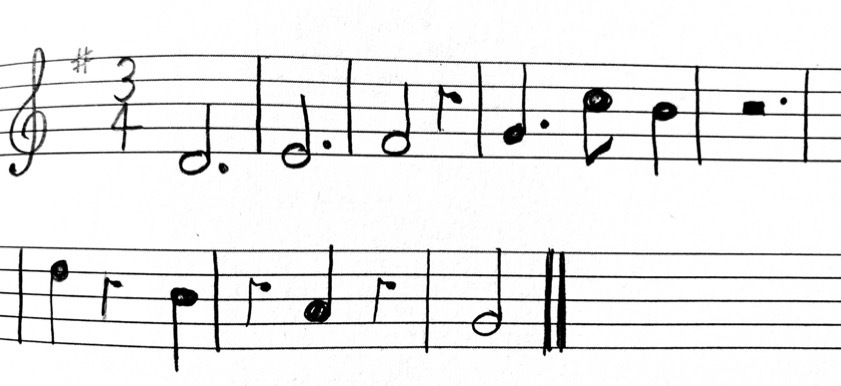
or in any way considered suitable.
When combined singing of the school takes place, the books should be used, and the song given to the younger children while the more advanced sing the variant or descant. When practicable, the latter should be given to comparatively few voices, say, in the proportion of one to the descant to three or four singing the melody.
The younger ones at first will be wise to pay strict attention to their own part, as they can be easily led astray by hearing something quite different going on above them.
I do not, of course, suggest that only the Shropshire Song Book should be used—but it is an instructive form of song—and judiciously used in conjunction with other books, accustoms children not to be always singing the top line.
Freedom and liberty are our sacred heritage in music, as in everything else—given a proper proportion of the “good,” the “indifferent” will soon be elbowed out.
The teaching can now be most usefully supplemented, viz., ear tests, which should be written down,[2] if slates or small music books are available, like ordinary dictation. Of course, quite simple at first and never very long, always having a complete understanding as to the DOH, such as:—
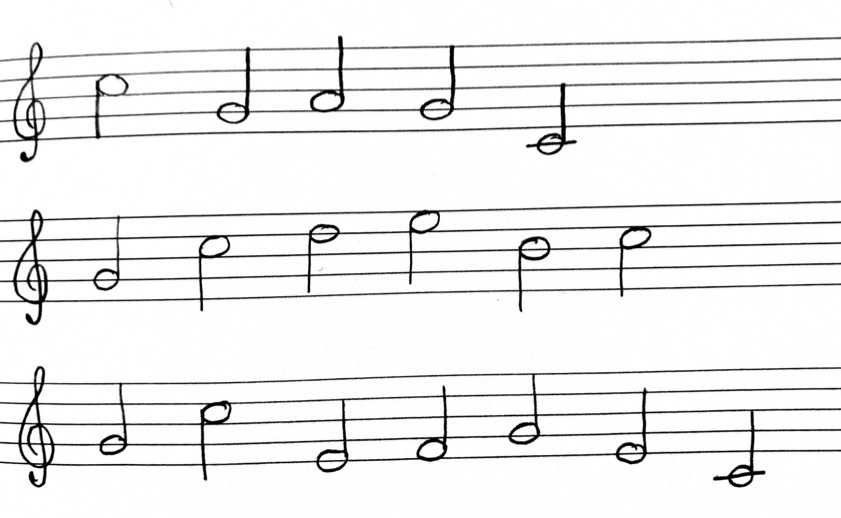
Then a step towards making tunes of their own.
Ask a question in music and point out that an answer comes by repeating the phrase backwards.
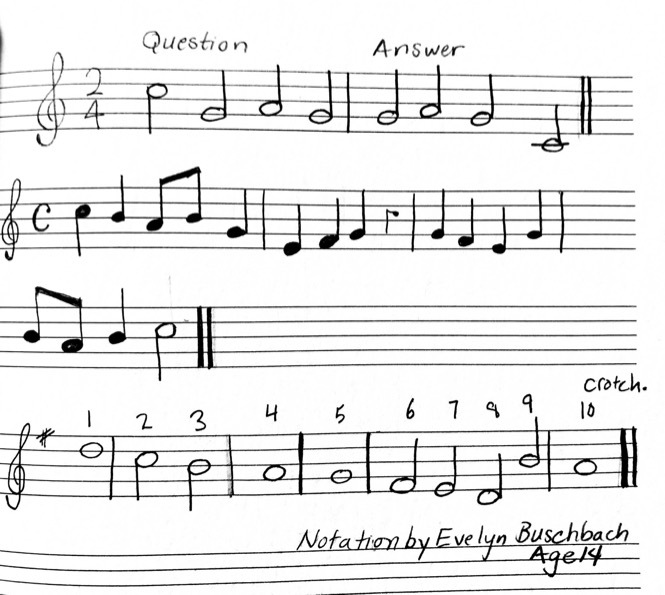
Take Dr. Crotch’s well-known chant. The notes are numbered. The above is the first half or question—take the notes in this order 4 3 2 1, 10 9 8 7 6 5 and you get the answer.
Children get accustomed to see the shape of melodies, and very soon carry dictation much further than the ordinary ear tests, i.e., they can write down quite considerable phrases—also time and rhythm tests.
Here again individual teaching is secured, and the time occupied is no greater than that occupied in ordinary class work.
Children in Classes III. and IV. should be able to read freely in the keys of C, G and F in the Staff, in \(\frac{4}{4},\) \(\frac{2}{4},\) \(\frac{3}{4},\) and perhaps \(\frac{6}{8}\) time with modulations from one key to another, and the Equivalents in the Tonic Sol-fa notation.
It has become customary to teach “Music” through the intermediary of the piano, or possibly some other instrument. The natural instrument is the voice. The result of instrumental teaching has been largely to eliminate the power of understanding music except through the medium of the instrument used. Many very skilled instrumental players are entirely lost if asked to produce sounds with the voice similar to those they play.
It would add enormously to musical receptiveness if the singing voice was reverted to as the medium in the same way as was the case before instruments were developed or even invented.
These remarks are intended as explanatory of and supplementary to the Memorandum issued by the National Council of Music of Wales, Music House, Aberystwith, and the author desires to acknowledge the very kind assistance he has always received from Sir Walford Davies and Mr. J. Chas. Maclean, in connection therewith.
[1] A very large number of songs are now published in the dual notation.
[2] Note.— This plan enables the teacher at once to see the individual capacity of each pupil.
Editor’s Note: The formatting of the above article was optimized for online viewing. To access a version which is formatted more similarly to the original, and which includes the original page numbers, please click here.
Subscribe: Apple Podcasts | Spotify | Amazon Music